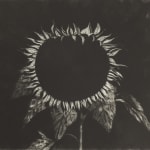Ken Currie
Sunflower Head, 2005
etching
50 x 60 cm
19 3/4 x 23 5/8 in
19 3/4 x 23 5/8 in
edition of 30
Published by Glasgow Print Studio
£ 870.00
Ken Currie’s working methods seem to be particularly suited to printmaking. As with the aquatint and etching processes, Currie develops his ideas and imagery over an extended period of time....
Ken Currie’s working methods seem to be particularly suited to printmaking. As with the aquatint and etching processes, Currie develops his ideas and imagery over an extended period of time. The particular kind of realism which Currie gives to his imagery, which is not naturalistic Studying Social Sciences but more interpretive, tending towards the allegorical, is very much suited to black and white printmaking, and goes back to the religious propaganda prints and broad-sheets of the Reformation.
Thus the evolving process of Currie’s intellectually didatic art can be continued throughout the printing process, with its continual re-working of the plate and the re-editing of the printed image. Currie’s images have moved from a philosophical outlook which had stong positive dimensions to one characterised by his own term “rational despair”. He has a fatalistic view about human nature, such dark thoughts seem to find their most effective means of expression through the black ink on the etched plate. Currie’s art reflects “The Dark Times” the present world is living through - his titles alone give warning of this. Most of Currie’s prints were inspired by his reaction to the Gulf War.
Apart from the imagery itself, much of the power of such prints lies in the ironic contrast between Currie’s depiction of such crowd scenes, Traditionally, such scenes of great crowds are a triumphant celebration of public order and civic unity. In Currie’s depictions, however, the crowd has turned into a mob.
Currie's work contains three broad, inter-related areas: a group of paintings concerned with how the human body is affected by illness, ageing and physical injury; a group of works exploring social and political issues and finally a set of
more elusive images speculating on abstract or philosophical questions. The idea of the body distressed by illness or disease can act as a metaphor for a reduced and unbalanced social world. The social and political subjects, so often reflecting a violent and brutalised culture, provide an ironic counterpoint to the triumphalism of contemporary civilisation, while the more obtuse, speculative works conjure with the fragile nature of being and of human existence.
Many of the paintings at first appear impenetrable, but it is their ambiguity that gives them their power. They exist at a precipice on the edge of understanding and being understood, and in this sense mirror the condition of human consciousness. This is a fundamental virtue in these works. They are replete with thought and idea, which is expressed in a profoundly visual experience. These are paintings and images which are contingent, for they exist in a constant process of becoming. These are surely the core qualities of a significant contemporary art, and Currie is undoubtedly one of the most powerful and evocative artists of our time.
Thus the evolving process of Currie’s intellectually didatic art can be continued throughout the printing process, with its continual re-working of the plate and the re-editing of the printed image. Currie’s images have moved from a philosophical outlook which had stong positive dimensions to one characterised by his own term “rational despair”. He has a fatalistic view about human nature, such dark thoughts seem to find their most effective means of expression through the black ink on the etched plate. Currie’s art reflects “The Dark Times” the present world is living through - his titles alone give warning of this. Most of Currie’s prints were inspired by his reaction to the Gulf War.
Apart from the imagery itself, much of the power of such prints lies in the ironic contrast between Currie’s depiction of such crowd scenes, Traditionally, such scenes of great crowds are a triumphant celebration of public order and civic unity. In Currie’s depictions, however, the crowd has turned into a mob.
Currie's work contains three broad, inter-related areas: a group of paintings concerned with how the human body is affected by illness, ageing and physical injury; a group of works exploring social and political issues and finally a set of
more elusive images speculating on abstract or philosophical questions. The idea of the body distressed by illness or disease can act as a metaphor for a reduced and unbalanced social world. The social and political subjects, so often reflecting a violent and brutalised culture, provide an ironic counterpoint to the triumphalism of contemporary civilisation, while the more obtuse, speculative works conjure with the fragile nature of being and of human existence.
Many of the paintings at first appear impenetrable, but it is their ambiguity that gives them their power. They exist at a precipice on the edge of understanding and being understood, and in this sense mirror the condition of human consciousness. This is a fundamental virtue in these works. They are replete with thought and idea, which is expressed in a profoundly visual experience. These are paintings and images which are contingent, for they exist in a constant process of becoming. These are surely the core qualities of a significant contemporary art, and Currie is undoubtedly one of the most powerful and evocative artists of our time.




